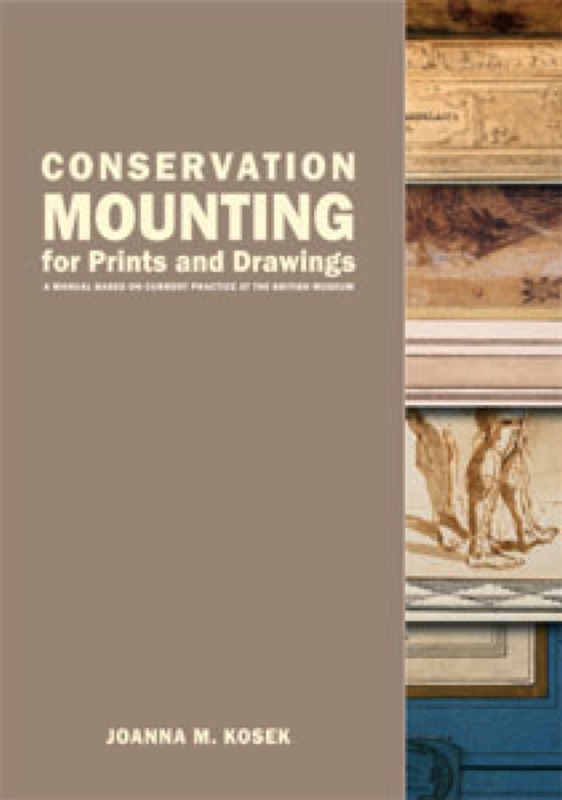As long ago as the 1850s, an attendant in the Printed Room at the British Museum devised the sunk mount to protect the stored prints and drawings from the adverse effects of handling. Mounts of this kind are now in universal use.
Attention to detail in the long-term care of prints and drawings has characterized the British Museum to the present day. In this book, the author and her colleagues have given us a rare and detailed insight into the workings of a practising mounting studio within a national institution. The history of mounting is traced using examples from the British Museum's collection, and the reader is taken visually, step by step through the processes and techniques used in the British Museum for mounting both western and Oriental prints and drawings.
A professional practical handbook with a comprehensive bibliography, glossary and index, Conservation Mounting for Prints and Drawings places the practice of mounting in context within the history of collecting, connoisseurship, conservation theory and collections management. This book will appeal to conservators, collection managers, curators and collectors.
Acknowledgements
Disclaimer
Foreward
Introduction
Part 1: Theoretical background
Outline history of the presentation of prints and drawings at the British Museum
The sunk mount
Early mounts
Plain, cream-coloured board mount
Mount board
Solander boxes
British Museum mount sizes
Stamping mounts
Mounters
Mounting Oriental art
Modern developments
Scientific background
Deterioration of objects
Standards for environmental condition
Reduced temperature storage
Anoxic storage
Environmental monitoring
Microenvironments for the storage of paper - Vincent Daniels
Relative humidity and temperature
Air pollutants
Offgassing
Migration of materials through paper
Current research into microenvironments
Mounting materials
Mounting board and papers
Japanese papers
Adhesives and plastic films
Photographic mounting materials
Terminology and standards
The conservation profession
ECCO Professional Guidelines: I The profession
ECCO Professional Guidelines: II Code of Ethic
Considerations before mounting
Preservation planning
Size, status and purpose of the collection
Access and use
Acquisition policy
Inherent environmental factors
Building and storage facilities
Budget for and availability of mounting materials
Staff and expertise
Historical and aesthetic considerations
Technical considerations
Practical checklist
Part 2: Mounting instructions
Sizes and thickness of mounts
Mount sizes for western objects
Mount sizes for Oriental objects
Thickness of mounts
Standard mount styles (storage and display)
Overthrow mount
Inset mount
Solid mount
Perspex verso mount
Perspex sandwich mount
Standard mounts for Oriental objects (storage and display)
Diptych mount
Triptych mount
Concertina mount
Apertures
Mount apertures for western objects
Single aperture
Multiple aperture
Circular aperture
Elliptical/oval aperture
Animated aperture
Mount apertures for Oriental objects
Single aperture
Diptych aperture
Triptych aperture
Concertina aperture
Fan aperture
Mounting for display (additional methods)
Back board mount
Temporary top window mount
Housing for storage (additional methods)
Protective flap
Polyester overlay in overthrow mount
Polyester enclosure in overthrow mount
Portfolio or folder mount
Corrugated board mount with boxboard flap
Portfolio for small thin books and pamphlets
Portfolio for large and thick books
Post-binders and housing series of loose sheets
Safeguarding and recreating historical mounts
Incorporating old mounts into standard styles
Incorporating archive material into new mounts
Recreating washline mounts
Recreating gilt mounts
Hinging
Pasted hinges
V -hinge
T-hinge
Paper tabs for float-mounted objects
Non-adhesive hinging methods
Photographic mounting corners
Polyester/polyethylene strips
Polyester window
Continuous polyester V-hinge
Polyester and paper welded hinge
'Stretch-hinging' parchment
Attaching heavy and distorted supports
Inlaying
Traditional inlaying method
Strip inlaying method
Slot inlaying method
Finishing operations
Finishing corners
Finishing edges
Finishing bevels
Part 3: Stamping instructions
Practical notes on stamping, tools and inking
Guidelines for typesetting
Guidelines for spacing
Guidelines for spacing of letters
Guidelines for spacing of numbers
Guidelines (miscellaneous)
Stamping mounts
Acquisition numbers
Artists' names
Collection stamps
Reference numbers
Acknowledgements
Instruction to turn over
Stamping portfolios and protective flaps
Portfolios
Mounts with protective flaps
Illustrated summary: stamping mounts
Stamping mounts for drawings
Stamping mounts for prints
Stamping covers/flaps/portfolios
Stamping objects
Prints
Drawings
Sketchbook
Books
Stamping multiple acquisitions, catalogue numbers and artists' names
Example 1 (double acquisition numbers)
Example 2 (two artists' names for one print)
Example 3 (two artists' names associated with one print)
Example 4 (multiple apertures/collection stamps)
Example 5 (double apertures in a landscape format mount with two artists associated with both prints)
Example 6 (double apertures in a portrait format mount with two artists associated with both prints)
Part 4: Mounting studio
Studio organisation
Studio design
Studio maintenance
Workflow organisation
Materials
Illustrated list of mounting materials
Materials: tips for use
Moistening and applying linen tape
Water-cutting and chamfering Japanese paper
Preparing wheat starch paste
Preparing methyl cellulose adhesive
Tools and equipment
Illustrated list of tools and equipment
Tools and equipment: tips for use and maintenance
Cutting apertures
Sharpening tools
Cleaning type
List of suppliers
List of professional organizations and online sources of information
List of paper conservation training institutions in the UK
Bibliography and further reading
Glossary
Index
Because it is so comprehensive and detailed, I expect this book will become a standard text on the subject of mounting and matting, and it certainly fills a need in the literature of paper conservation. I would urge all paper conservators and mount makers to buy a copy and keep it close at hand.
Journal of the Canadian Association for Conservation 29 (2004) 39-40
Für Konservierunstechniker in Graphischen Sammlungen sowie Konservierungseinrahmer sollte dieses Handbuch ebenso zur Standardlektüre gehören und immer zur Hand sein, wie als Nachschlagewerk für Kuratoren und Galeristen die für die Bewahrung und Pflege einer Sammlung verantwortlich sind.
Papier Restaurierung 7(1) (2006) 8-10
The focus on presentation provides a good illustration of the different demands placed on framers and conservators…The conservation and museum community will undoubtedly find this an excellent book…I recommend this book as an essential reference book for any framer’s shelf...
Art Business Today (January 2005) 75
